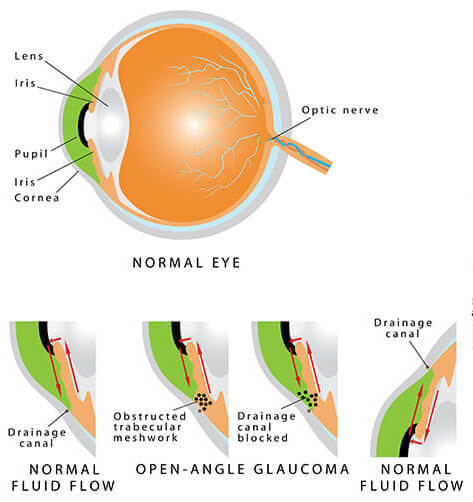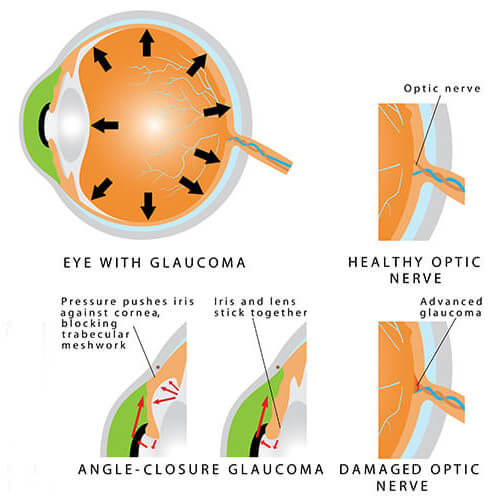Glaucoma is a condition that causes damage to your eye’s optic nerve and gets worse over time. It’s often linked to a buildup of pressure inside your eye. Glaucoma tends to be inherited and may not show up until later in life. The increased pressure, called intraocular pressure, can damage the optic nerve, which transmits images to your brain. If the damage continues, glaucoma can lead to permanent vision loss. Without treatment, glaucoma can cause total permanent blindness within a few years.
Most people with glaucoma have no early symptoms or pain. You need to see your eye doctor regularly so she/he can diagnose and treat glaucoma before long-term visual loss happens.
As the optic nerve becomes more damaged, blank spots begin to appear in your field of vision. ‘These blind spots usually go unnoticed until significant damage is done to the optic nerve. It is important to diagnose and prevent damage before this happens.

At Office Park Eye Center , we screen patients who are suspicious for glaucoma with three different devices that assist in detecting the disease as early as possible. Damage caused by glaucoma is irreversible, but by early detection and treatment it can be prevented.
The goal for treatment of glaucoma is to lower the eye pressure and this can be done with eye drops or a glaucoma laser that we perform in office called selective laser trabeculoplasty (SLT). The laser procedure helps to eliminate or decrease the need for eye drops and is covered by insurance.
If you’re over age 40 and have a family history or the disease, you should get a complete eye exam from an eye doctor every 1 to 2 years. If you have health problems like diabetes or a family history or glaucoma or are at risk for other eye diseases, you may need to go more often.
Narrow Angle Glaucoma
Acute narrow-angle glaucoma occurs suddenly, when the colored portion of your eye (iris) is pushed or pulled forward. This causes blockage of the drainage angle of the eye, where t he trabecular meshwork allows outflow of fluids.

When internal eye structures are blocked in this way, your eye’s internal pressure (intraocular pressure or IOP) may spike and possibly damage the optic nerve that transmits images from the eye to the brain.
Acute angle-closure (closed-angle or narrow-angle) glaucoma produces symptoms such as eye pain, headaches, halos around lights, dilated pupils, vision loss, red eyes, nausea and vomiting.
These signs may last for hours or until the IOP is reduced. With each narrow-angle glaucoma attack, part of your peripheral vision may be lost.
Acute angle-closure glaucoma is a medical emergency. If the high eye pressure is not reduced within hours, it can cause permanent vision loss. Anyone who experiences these symptoms should contact an ophthalmologist immediately or go to a hospital emergency room.
At Office Park Eye center we screen every patient and asses their risk of developing Angle Closure Glaucoma. We can prevent Angle Closure from happening with a preventative Laser treatment called a Peripheral lridotomy. This is covered by insurance and is done in the office. This is another reason why it is so important to have your eyes screened regularly.
